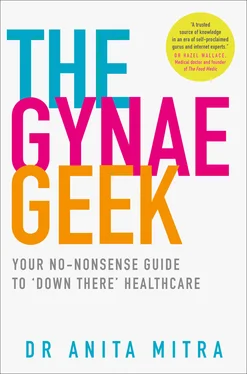Vagina This refers to the muscular tube inside that goes from your vaginal opening on the outside, up to the cervix. Your vagina cannot be seen from the outside (hence the inaccuracy of the question: ‘Does my vagina look normal?’), and at about 7–9cm long, it has an amazing degree of elasticity and can expand in all directions – enough to allow for the birth of a baby. Its expansive nature also means it can also accommodate many a foreign object.Possibly the most unusual thing I’ve ever removed from someone’s vagina was a disco ball. Not a massive one from the ceiling of a 70s club, but one that was golf-ball-sized and originally belonged on a key chain. It was 7 a.m., and the end of a particularly harrowing night shift in A&E, but having been told that the offending object was a key ring, I thought it would be a quick job. Then the triage nurse casually added: ‘Oh, by the way, Doc, the key ring itself has snapped off and it’s just the disco ball left inside now …’ Needless to say, it certainly was a challenge, largely due to the fact that your vagina can make a pretty impressive vacuum, but I got it out in the end. If the owner of said disco ball is reading this, I just want to say how much I still feel your pain and embarrassment to this very day.
Labia majora These are the larger, skin-covered outer lips of the vulva. The skin here is usually darker than the rest of the surrounding skin and has a fatty layer underneath that plays a protective role.
Labia minora These are the inner, more fleshy-looking lips, that are usually quite red or pink and probably what cause the most concern with regards to what’s ‘normal’. Most women’s labia minora will be visible below the labia majora and it’s common for them to be asymmetrical. The average size ranges from 2–10cm in length and 1–5cm in width1 and consequently the appearance of the labia minora varies significantly from one woman to the next. It’s kind of ironic how teenage boys (and let’s be honest, most immature men) boast about the size of their penis, yet women are expected to have neat, tucked-in labia that never see the light of day. Why is this? Because they originate from the same embryological structure. It is normal for them to seem to enlarge slightly with age due to loss of collagen and oestrogen, both of which support the structure of the tissue.
Perineum This is the area between the back of the vaginal opening and the anus.
Pelvic-floor muscles Your pelvic floor is underneath the skin of the perineum and is made up of several muscles and pieces of connective tissue that act as a sling to hold your insides in. Pelvic-floor weakness can lead to prolapse of the vaginal walls, bladder, urethra or the uterus. A lot of people think you can only get a prolapse if you’ve had a baby, or if you’ve had a vaginal delivery, during which these muscles may tear or be cut to facilitate delivery. However, this is not the case, and it can happen to anyone – regardless of whether they’ve only ever had C-sections, or even if they’ve never had a baby. The pelvic-floor muscles also help you to maintain control of your bladder and bowel.
THINGS YOU’VE ALWAYS WANTED TO KNOW, BUT WERE TOO AFRAID TO ASK
Is ‘down-there’ hair removal safe?
Generally speaking, yes. Minor cuts, burns and ingrown hairs may occur as a result, but they’re rarely severe enough to require medical attention. The most commonly reported reason given for removing pubic hair is for hygiene purposes, 2however there isn’t actually any evidence to show that it improves hygiene or reduces the risk of infections. I think this belief is perpetuated by the myth that your vulva and vagina are dirty and teeming with germs. As doctors, we don’t judge or have a preference about the terrain down there, so don’t feel you have to schedule a waxing/shaving session before an appointment. I’ll take it as it comes, thank you!
Will having lots of sex make my vagina loose?
No. Regardless of what the teenage boys in the playground may have said, this is not true. Your vagina is very elastic and can expand enough to let a baby out (and other objects in) but it always shrinks back. While having a baby may change the shape of your vagina slightly, having sex will not because a penis is not large enough to do so. Having sex will also not change the size or shape of your labia minora.
Do I need a labiaplasty?
Absolutely not! Labiaplasty is surgery to trim the labia minora and/or clitoral hood. It is largely performed for cosmetic reasons. I think that the sudden interest in ‘neatening up’ one’s labia may be an undesirable offshoot of the current obsession with aesthetic ‘perfection’. There are numerous plastic surgeons around the world advertising labiaplasty as a quick and simple procedure to make your labia more symmetrical/neat and tidy, etc. But symmetry is overrated – no other body part is truly symmetrical: we’ve all got one foot that’s bigger than the other, eyebrows that don’t match. And it’s the same with labia. It’s also normal for your labia minora to be visible on the outside, although Barbie and the porn industry may tell you otherwise. There is minimal evidence to show that the surgery actually improves pain, sexual function or how women feel about their genitalia, plus there is a risk of pain after the surgery due to nerve damage or resulting scar tissue, so it’s really not a decision to take lightly. And it cannot be reversed in the same way that you could, for example, have breast implants removed. As a famous professor once pointed out: ‘If you think your labia are too long, stop shaving off your pubic hair and you’re unlikely to think so.’
When should I start doing pelvic-floor exercises?
Right about … now! Also called Kegel exercises (see here), everyone should be doing them, regardless of whether they are pregnant or have ever had a baby, because that’s not the only thing that weakens them. They generally weaken with age, so you want them to be as strong as possible from a young age. Doing pelvic-floor exercises in pregnancy, especially from an early stage, has also been shown to reduce the amount of time it takes to push your baby out, and the risk of leaking urine after the birth. 3, 4Many people think having a Caesarean section prevents pelvic-floor weakness, but that’s not the case. Carrying around several kilos of extra weight for nine months will put extra strain on the pelvic floor whether you push out that watermelon or it comes out the sunroof!
THE GYNAE GEEK’S KNOWLEDGE BOMBS
The female vulva can generate a great deal of anxiety, but I hope you now feel more comfortable with describing the different areas should you ever need to talk to a doctor about it.
The following are the key facts that I would like you to take away from this chapter:
Your vulva is on the outside; your vagina is on the inside.
Your vulva looks normal. Don’t let anyone tell you otherwise.
Pubic hair removal is safe but doesn’t carry any health benefits, so don’t feel you have to do it.
You do not need a labiaplasty if it’s purely for appearance reasons. It’s normal for your labia minora to hang below the labia majora and for one to be longer than the other. It’s Barbie who got that part wrong, not you.
Your pelvic-floor muscles are the lifelong friends that you need to get to know. Kegel exercises (see here) are the most underrated workout that we should all be doing, not just in pregnancy.
CHAPTER 2
Internal female genital anatomy
(While I’m performing a vaginal examination to look at a patient’s cervix):
‘Doctor, do my ovaries look healthy?’
To be clear, I can’t see your ovaries when I’m looking up inside your vagina. Yet I’ve been asked this question on multiple occasions, which tells me that many women may need a refresher of that uninspiring biology class that we all sat through at school. I’ll tell you about the cervix – what even is that? And a cervical ectropion, which is actually very common and completely healthy, yet one of the most anxiety-provoking things that I find myself explaining again and again. I’ll also tell you about a few of the interesting lumps and bumps that I spend a lot of time talking about in clinic that can cause a lot of confusion, usually made worse by my rogue friend Dr Google.
Читать дальше












